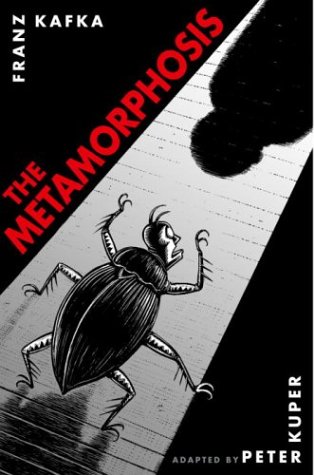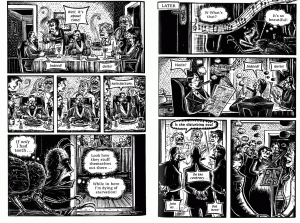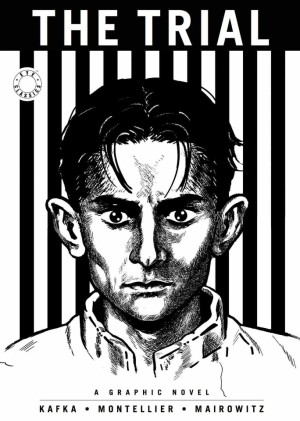Review by Graham Johnstone
Franz Kafka’s novella The Metamorphosis is one of the most acclaimed works of modern literature. Considering this and its elements of fantastical horror, it’s surprising it’s not been adapted into comics more often.
Peter Kuper had already adapted a number of the Czech master’s short stories, which were collected in 1999 as Kafka: Give it Up! The introduction by Jules Feiffer describes these as “[a series of] riffs, visual improvisations… jazz”. Kuper’s treatment of The Metamorphosis, though, is a faithful adaptation of the original.
The most obvious way Kuper makes this his own is with his striking scraper-board drawings: the angular lines incised white into black, and edgy, almost obsessive rendering. This had become Kuper’s default technique, but it’s particularly apposite here. It channels the woodcut prints of German Expressionism – a movement close to Kafka, not only in time and place, but also in its emphasis on a more personal and internal reality. Kuper is a virtuoso of scraper-board, effortlessly combining expressive figures with naturalistic settings. He makes great use of the white lines on black to convey light – a poignant evocation of the outside world entering the home Gregor may never get to leave.
Kuper’s also a master of page design, with each composed for both visual appeal and storytelling demands. A particular highlight is the page of Gregor learning to walk across the walls and roof. The text leads us around his route, requiring repeated rotation of the book, until we arrive at the middle of the page, from where he falls to the floor, and panel, below.
In adapting the text, Kuper retains most of Gregor’s narrative monologue, though rewording it from existing translations to more terse everyday language. The drawings render most of the description redundant, so Kuper sensibly omits it. In a mere eighty small pages, he retains all key story elements: Gregor Samsa’s awakening and realisation he has turned into a “vermin”; his sacking from his job and loss of status as the family breadwinner; his family’s shock and grudging acceptance; then their struggles to cope financially and practically, necessitating three lodgers, and an intimidating “charwoman”. These plot events are drivers for the underlying psychological story, and this is where Kuper really takes flight.
Scenes reflecting Freud’s Oedipus Complex exemplify how these various elements work together. Gregor had been the family’s breadwinner, symbolically castrating his bankrupted and disabled father, however, his metamorphosis and consequent dismissal from his job reverses this. This is a key turning point and the climax of Part I, and Kuper powerfully conveys this with the father a massive figure, cropped off the page and overlapping several small panels of chastened insect Gregor. His father’s walking stick (now brandished as a weapon), and a kicking boot burst into panels of a cowering Gregor. An escalation of this ends Part II. His father now has a position of authority, albeit as a lowly guard. Kuper draws him as a giant towering over Gregor. As he throws his guard hat at him, his hand thrusts violently into the next page. Gregor’s symbolic castration is completed as his mother intervenes to protect him, and we see over a series of panels Gregor scurrying towards the edges of the page, and looking impotently back at his mother, before his limp neck sags into the far, bottom corner of the page.
Kuper’s judicious adaptation of the text, masterful page layouts, evocation of period aesthetics, and effortless combination of the naturalistic with angst filled expression, bring Kafka’s masterpiece to vivid life. It’s a triumph, and one of the very best adaptations of literature to comics.




